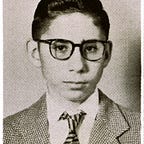Juan Manuel Sánchez — The Essence of a Woman
I have a project. I have an important project. It involves a very good friend who by circumstances beyond his control spends most of the day in secluded daydreaming.
His name is Juan Manuel Sánchez. He is an 86 year old Argentine painter part of a group called Movimiento Espartaco or Grupo Espartaco (1959–1968) of 9 artists (Esperilio Bute, Pascual Di Bianco, Elena Diz, Ricardo Carpani, Raúl Lara, Mario Mollari, Juan Manuel Sánchez, Carlos Sessano and Franco Venturi).
Espartaco promoted social art in that terrible decade in Argentina of military coups that brought in the generals that disappeared people. They rejected what they considered to be cultural colonialism, perhaps noticing the globalization and the Starbucking of the world to come.
Juan Manuel Sánchez married Argentine painter Nora Patrich and they moved to Vancouver in the late 80s. For about 10 years these friends of mine and I collaborated in a multitude of projects the principal one being abpout our nostalgia for our native land and city of Buenos Aires.
Five years ago the couple separated and returned to Buenos Aires in separate airplanes.
Sánchez lives in his little studio in downtown Buenos Aires. It is neat as a pin but he is beginning to lose his short term memory and does little work even though as I found out in April of this year he has not lost his immaculate artistic ability.
Having returned to Vancouver I want to see this man somehow press out from his mind all that knowledge that has come from years of wielding a brush and principally painting his obsession - to find Plato’s essence of what a woman is. Sánchez once told me that one day he will paint one line, or perhaps a dot on a large canvas when he has finally resolved (he uses the more elegant resolver in Spanish) what that essential (or essence )woman is.
I sat down with him for coffee and for a strong fortified sweet wine called moscato in a nearby café from his studio on Paraguay and Talcahuano. We talked about art and music and inspiration. I grieved at the huge distance that is between us geographically. At one time he was very good with a computer but once he arrived in Buenos Aires he had one no more. I communicate with him via Skype (my computer to his phone). We have long conversations.
I am convinced that to keep his alertness and at the same time to gain something from him that would be a patrimonio nacional, he has to sketch, draw and paint. Lately, in the beginning of a bitter Buenos Aires winter, he stays home. I can imagine him staring out the window. On the other side is an apartment where Sánchez has told me Jorge Luís Borges lived. Sánchez lives a few blocks from the Teatro Colón opera house and yet there he is silent and unmoving in a limbo of the imagination. The trick is to coax out that imagination.
I have found a solution.
It is in the form of a lovely 35 year old woman (a mother of two boys) who is going to be introduced to Sánchez in his apartment by Nora his former wife. She will then pose for him and Sánchez will do what he does best. Cris (Cristina) will chat and ask questions and get an accelerated arts education. She will get sketches and perhaps even paintings. Will she be his last muse?
When people in Vancouver ask me about Sánchez I compare him to the great Canadian painter Jack Shadbolt. Would Shadbolt have been allowed to live in such isolation?
I have told Sánchez that if he really gets enthused to contact me immediately and I will fly to Buenos Aires like a shot. We would then collaborate.
Originally published at blog.alexwaterhousehayward.com.
